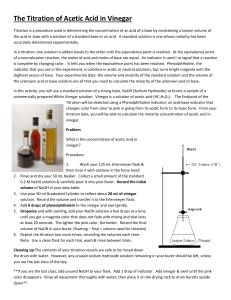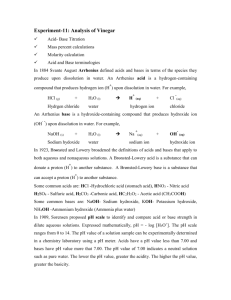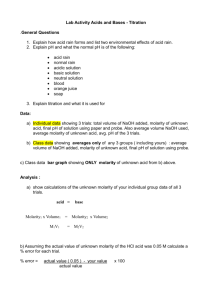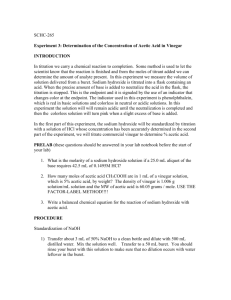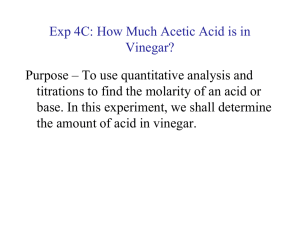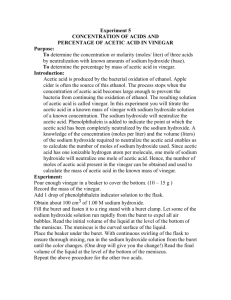The Concentration of Acetic Acid in Vinegar
advertisement
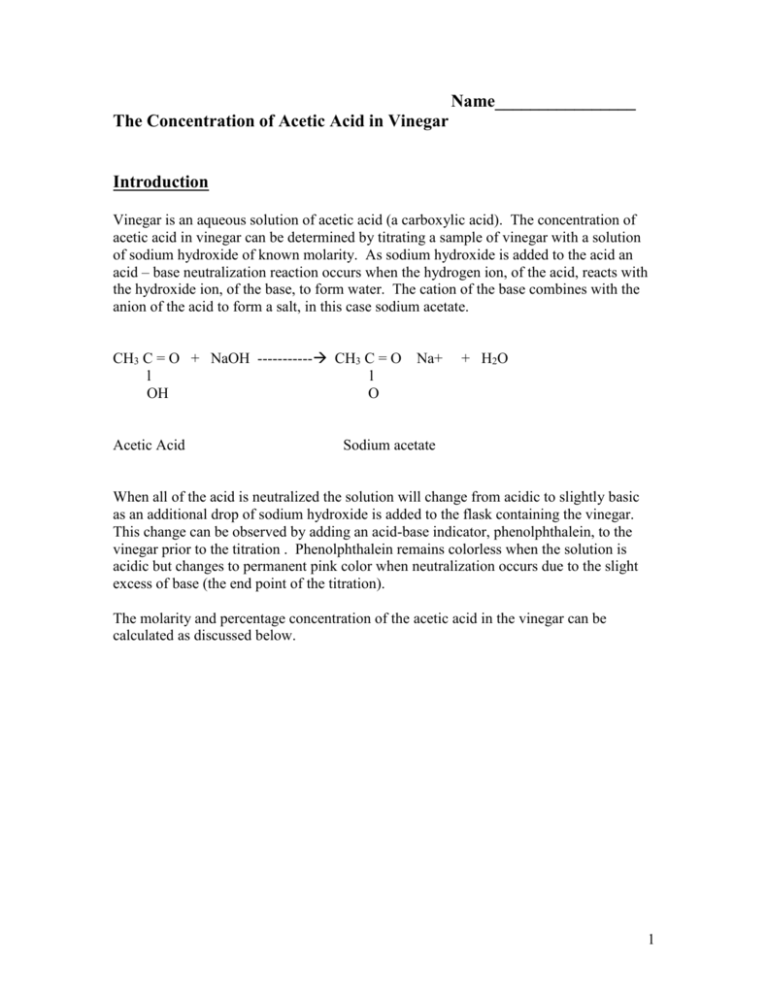
Name________________ The Concentration of Acetic Acid in Vinegar Introduction Vinegar is an aqueous solution of acetic acid (a carboxylic acid). The concentration of acetic acid in vinegar can be determined by titrating a sample of vinegar with a solution of sodium hydroxide of known molarity. As sodium hydroxide is added to the acid an acid – base neutralization reaction occurs when the hydrogen ion, of the acid, reacts with the hydroxide ion, of the base, to form water. The cation of the base combines with the anion of the acid to form a salt, in this case sodium acetate. CH3 C = O + NaOH ----------- CH3 C = O l l OH O Acetic Acid Na+ + H2O Sodium acetate When all of the acid is neutralized the solution will change from acidic to slightly basic as an additional drop of sodium hydroxide is added to the flask containing the vinegar. This change can be observed by adding an acid-base indicator, phenolphthalein, to the vinegar prior to the titration . Phenolphthalein remains colorless when the solution is acidic but changes to permanent pink color when neutralization occurs due to the slight excess of base (the end point of the titration). The molarity and percentage concentration of the acetic acid in the vinegar can be calculated as discussed below. 1 PROCEDURE 1. Using a 10.00 mL graduated cylinder, place 5.00 mL of vinegar in a clean Erlenmeyer flask. Record the volume of the vinegar used (usually 5.00 mL). Add 25.00 mL of distilled water to the flask using a graduated cylinder. Add 2-3 drops of phenolphthalein to the flask. (don’t forget this) 2. Set up the buret as instructed and place a white piece of paper under the Erlenmeyer flask. Place about 100mL of NaOH of known molarity in a beaker and carry it to your table. Rinse the buret with a small amount of NaOH. Fill the buret with NaOH as instructed. Make sure that you allow the NaOH to run through the buret until the volume reading is 0.00mL and there are no air bubbles trapped in the tip of the buret. 3. Record the volume of NaOH in the buret (Usually 0.00mL). Use a white piece of paper placed against the buret to read the bottom of the meniscus each time you take a volume reading. Begin adding NaOH to the Erlenmeyer flask as you add the NaOH. As you approach the end point of the titration, the pink color will disappear more slowly. At a certain point, one drop of NaOH will cause the entire solution to turn to a faint PERMANENT pink color. This is the end point of the titration. Record the volume of NaOH used to reach this end point. The volume should be recorded with two digits behind the decimal (example 12.00mL). 4. Repeat the procedure two more times using fresh 5.00mL samples of vinegar. CALCULATIONS The MOLARITY of the Acetic Acid can be calculated as follows: Macid x Vacid = Mbase x Vbase Macid = molarity of acid, Vacid = volume of acid , Mbase = molarity of base Vbase = volume of base The molarity of the base is known (given by the instructor), the volume of the acid is equal to the volume of the acetic acid added to the Erlenmeyer flask (5.00mL) and the volume of the sodium hydroxide required for the neutralization can be read from the buret. By rearranging the equation and substitution, the molarity of the acetic acid can be determined. The PERCENTAGE CONCENTRATION OF ACETIC ACID in the vinegar can be calculated as follows: The molar mass of acetic acid is 60.00 g / mole. % acetic acid = Molarity (mol/liter) x Molar mass (g/mole) 10 2 RESULTS and CALCULATIONS Run 1 Run 2 Run 3 Volume of vinegar ______ ______ ______ Initial level of NaOH ______ ______ ______ Final level of NaOH ______ ______ _______ _______ _______ Volume of NaOH used ______ Molarity of NaOH from instructor __________ Molarity of acetic acid ______ (from your calculation) shown below) ________ _______ Percentage conc. of ______ Acetic acid (from your calculations) shown below) _________ ________ average % of acetic acid ___________________ 3


